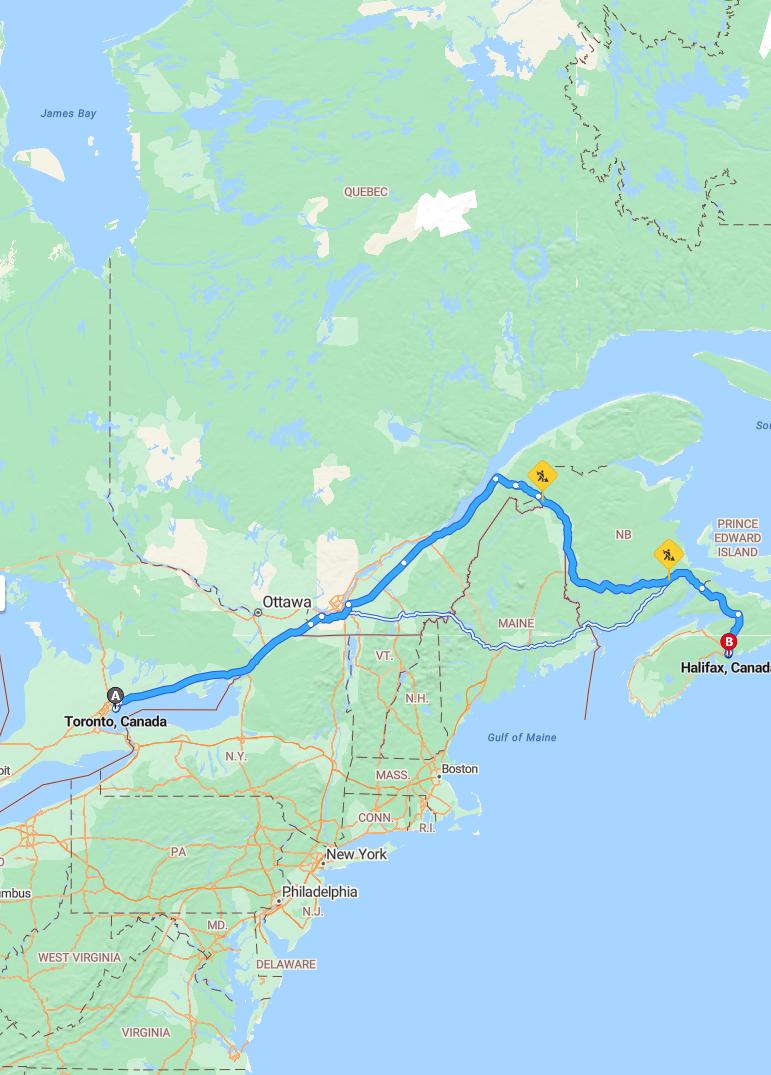Distance and estimated driving time
Traveling from Toronto to Halifax covers approximately 1,114 miles and is estimated to take around 16 hours and 30 minutes. The most common route involves taking the ON-401 E through Ontario and then transitioning onto TC-2 E, guiding you through scenic and efficient highways. Planning for rest stops and overnight accommodations is advisable given the length of the journey. Overall, this drive offers a remarkable cross-country experience with diverse landscapes and regional attractions along the way.
Driving route
Embarking on a road trip from Toronto to Halifax offers a diverse and scenic journey through eastern Canada. Starting in Toronto, travelers will pass through the vibrant city of Ottawa, known for its historic parliament buildings and cultural attractions. Continuing northeast, the route takes you through picturesque Quebec, where charming Old Town streets invite exploration. As you approach the maritime provinces, a visit to Prince Edward Island provides stunning coastal scenery and warm hospitality. Finally, arriving in Halifax, travelers can enjoy its rich maritime history, lively waterfront, and welcoming communities, making this route a memorable exploration of Canada's Atlantic region.

Best stops and sightseeing points along the route
Journeying from Toronto to Halifax offers a variety of captivating stops and sightseeing opportunities. Travelers can explore the historic streets of Ottawa, including Parliament Hill and the Rideau Canal, before heading to Quebec City's charming Old Town featuring cobblestone streets and magnificent fortifications. A scenic detour to Prince Edward Island provides stunning coastal views and attractions like Green Gables. Finally, reaching Halifax, visitors can enjoy its vibrant waterfront, historic sites such as the Citadel Hill, and the picturesque Peggy's Cove lighthouse, making the trip both enriching and memorable.
Road conditions and weather forecast
The drive from Toronto to Halifax covers a diverse range of road conditions and weather patterns. Travelers can expect well-maintained highways through Ontario and Quebec, with possible winter weather, especially in northern areas, which may include snow and icy patches, making driving conditions more challenging. As you progress into the maritime provinces, the roads remain generally good, but weather can shift rapidly, with rain or fog prevalent near the coast. It is advisable to check local weather forecasts regularly and prepare for varying conditions to ensure a safe and smooth journey across this scenic route.
Fuel stations and rest areas
Traveling from Toronto to Halifax, drivers will find numerous fuel stations and rest areas along the route, ensuring convenient refueling and breaks. Major highways connecting these cities, such as the Trans-Canada Highway, are well-equipped with amenities including gas stations, restaurants, and visitor centers. Rest areas are strategically located to provide a comfortable space for shortXiu Xi and refreshment, promoting safe driving. Planning stops at these facilities enhances the travel experience, making the journey smoother and more enjoyable for travelers.
Accommodation options en route
Travelers driving from Toronto to Halifax have a variety of accommodation options along the route, including hotels and motels in major cities like Ottawa, Quebec City, and Halifax, offering comfort and convenient amenities. In smaller towns and scenic areas, there are cozy bed and breakfasts, inns, and boutique lodgings that provide a more personalized experience. Prince Edward Island also offers charming coastal inns and resorts for travelers seeking relaxation by the ocean. Booking in advance is recommended, especially during peak travel seasons, to ensure availability and enjoy a comfortable stay throughout the journey.
Local cuisine and dining recommendations
Traveling from Toronto to Halifax offers a delightful culinary journey through Eastern Canada. In Toronto, savor diverse international cuisines, with notable spots like St. Lawrence Market offering fresh seafood and artisanal delights. Ottawa's local favorites include poutine and maple-infused dishes, perfect for warming up in the city's cozy cafes. As you reach Quebec, indulge in hearty French-inspired cuisine, while Prince Edward Island is renowned for its succulent oysters and lobster. Finally, Halifax provides a vibrant seafood scene, with waterfront restaurants serving up freshly caught scallops and Atlantic salmon, making each stop a memorable gastronomic experience.
Travel safety tips and guidelines
When driving from Toronto to Halifax, it is essential to prioritize safety by ensuring your vehicle is well-maintained and all systems are functioning properly before the trip. Plan your route in advance, stay aware of current road conditions, and keep an emergency kit, including first aid supplies and basic tools, readily available. Maintain a safe following distance, adhere to speed limits, and avoid distractions such as mobile phone use while driving. Additionally, take regular breaks to stay alert, especially during long stretches through less populated areas like Prince Edward Island and Quebec, to ensure a safe and enjoyable journey.
Vehicle maintenance tips for long drives
Embarking on a long drive from Toronto to Halifax requires thorough vehicle maintenance to ensure safety and prevent breakdowns along the route. Before departure, check the engine oil, coolant levels, and tire pressure to maintain optimal performance and fuel efficiency. It's also essential to inspect the brakes, headlights, and windshield wipers for proper functioning, especially for navigating diverse weather conditions across provinces. Additionally, packing emergency supplies such as a first aid kit, flashlight, and spare tire can provide peace of mind during the journey.
Local laws and driving regulations
When traveling from Toronto to Halifax, drivers should familiarize themselves with local laws and driving regulations in each region. In Ontario, seat belt use is mandatory, and hands-free devices are required for mobile phone use while driving. Quebec enforces strict rules against using handheld devices and has a higher alcohol blood alcohol content (BAC) limit of 0.08%. In Atlantic Canada, including Prince Edward Island and Nova Scotia, speed limits vary by area, and adherence to local signs is essential for safe and legal travel across provinces.
